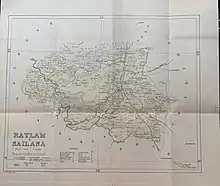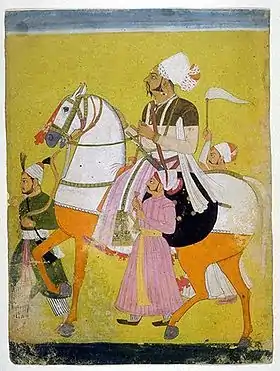Ratlam State
Ratlam State[1] was a 13 gun salute (15 local) princely state in India, part of the Malwa Agency of Central India during the British Raj.
| Ratlam State रतलाम रियासत | |||||||
|---|---|---|---|---|---|---|---|
| Princely State of British India | |||||||
| 1652–1948 | |||||||
 Flag
 Coat of arms
| |||||||
 A map showing the division of Ratlam and Sailana. | |||||||
| Area | |||||||
• 1901 | 2,336 km2 (902 sq mi) | ||||||
| Population | |||||||
• 1901 | 83,773 | ||||||
| History | |||||||
• Established | 1652 | ||||||
| 1948 | |||||||
| |||||||
| Today part of | Madhya Pradesh, India | ||||||

.jpg.webp)
.jpg.webp)
The state's capital was Ratlam town in modern Ratlam district of Madhya Pradesh. Ratlam State was originally a prosperous kingdom, its parganas included Dharad (Ratlam), Raoti, Dhamnod, Badnawar, Dagparawa, Alot, Titrod, Kotri, Gadgucha, Agar, Nahargarh, Kanar, Bhilara and Ramgharia yielding a revenue of Rs.53,00,000 in the 17th century. Maharaja Ratan Singh Rathore of Ratlam supported Dara Shukoh during the Mughal succession war. However Dara Shukoh lost and Ratan Singh was killed in battle. The new emperor Aurangzeb annexed Ratlam and reduced the state to a great extent. The state further lost land to the Scindias of Gwalior. During British rule in 1901 the state had an area of 1795 km2 and an estimated revenue of Rs.5,00,000.[1][2]
History
The rulers of Ratlam were originally princes and Jagirdars (nobles) of Marwar. Dalpat Singh, who was the 4th son of Raja Udai Singh of Marwar was given the jagirs of Balaheda, Pisangan and Kherwa. Dalpat Singhs son Maheshdas Rathore was given the jagir of Jalore by the Mughal emperor Shah Jahan for his successful campaign against the Pashtun tribes of Afghanistan. Maheshdas Rathore's son Ratan Singh continued his father's legacy as a Mughal general in Afghanistan. He repelled Central Asian marauders and campaigned against the Persian Safavids with the Mughal prince Dara Shukoh.[3]
Shah Jahan made Ratan Singh the Maharaja of Dharad for his bravery shown against the Persians at Khorasan and the Uzbeks at Kandahar. Ratan Singh had also shown his bravery by killing the emperors favourite elephant. The imperial elephant had trampled several civilians in Agra and none could stop its rampage, but Ratan Singh quickly climbed the elephant and killed it by stabbing its neck with a katar. Shah Jahan was so impressed by the heroics shown by Ratan Singh, that he gave him the parganas of Dharad, Raoti, Dhamnod, Badnawar, Dagparawa, Alot, Titrod, Kotri, Gadgucha, Agar, Nahargarh, Kanar, Bhilara and Ramgharia. Maharaja Ratan Singh thus founded the kingdom of Dharad in 1652 (predecessor to the State of Ratlam). Ratan singh was given the titles of Maharajadhiraj, shree Huzur and Maharaja Bahadur by Shah Jahan. He was further decorated with the insignias of chaur (yak's tail), morchal (peacock plumes), suraj mukhi (fans with a representation of the sun and moon) and mahi-maratib (insignia of the fish).[4] Ratan Singh was killed in battle while fighting the Traitor son of Shah Jahan, Aurangzeb in Dharmatpur, his wife Maharani Sukhroopde Kanwar Shekhawat Ji Sahiba committed sati in 1658. Ratan Singhs sons ruled in different areas in the Malwa region. The Rajas of Ratlam State, Sailana State and Sitamau State were descendants of Ratan Singh.
Ratlam was initially harassed by the Gwalior Kingdom, but on 5 January 1819 it became a British protectorate, following which an arrangement was made by which the Sindhia engaged never to send any troops into the country or to interfere with the internal administration in return for a yearly tribute. The tribute amounting to Rs.42,700 was later paid to the British government.[5] In 1861 the tribute was assigned to the British government in part as payment of the Gwalior contingent.[5]
During British rule, the State had an area of 1795 km2, which was closely interlaced with the territory of the princely State of Sailana. In 1901, the state had a population of 83,773; the town of Ratlam had a population of 36,321. The state enjoyed an estimated revenue of rs.5,00,000. The town was a junction on the Rajputana-Malwa Railway, and was an important trade centre, especially of opium.[5]
The state's last ruler signed the instrument of accession to the Indian Union on 15 June 1948.
Rulers
The rulers were Ratanawat Rathore Rajputs and were closely related to the ruling families of Sailana, Sitamau, Kachhi Baroda and Multhan.[1][6]
Maharajas
| Date of Reign | Maharajas of Ratlam | Note |
|---|---|---|
| 1652–1658 | Ratan Singh (d.1658) | Courageous in youth, he gained emperor Shah Jahan's notice by slaying the Emperor's favourite elephant which had run amok in the Agra Palace Garden, fought for the Emperor against the Persians in Kabul and Kandahar, later in 1652, the Emperor substituted Jalore for the pargana of Ratlam and many other areas, and he became the first Raja of Ratlam, in 1658 a false rumour of the death of the Emperor resulted in a frenzied scramble for succession to the throne amongst his sons. Dara Shikoh who was officiating for his father, sent a combined army of Rajputs and Muslims under the command of Maharaja Jaswant Singh of Jodhpur, against his brother Aurangzeb. The Maharaja, as head of the Rathore clan, was persuaded to hand over command of the Imperial army to Maharaja Ratan Singh. Non-cooperation by the Muslim commanders resulted in the army sustaining heavy losses in the fierce battle at Dharmat, as well as the death of Ratan Singh (said to have sustained 80 sword wounds on his body), he married (amongst others), Maharani Sukhroopde Kanwar Shekhawat Ji Sahiba, daughter of Kunwar Purshottam Das of Jhajhar [Shekhawati], and had issue. He died 1658 in battle at Dharmat near Ujjain.}} |
Rajas
| Date of Reign | Rajas of Ratlam | Note |
|---|---|---|
| 1695–1706 | Chhatrasal (d. 1712) |
He was the seventh son of Maharaja Ratan Singh. He held the Mughal rank of 1500 Zat and 1500 Sawar. A great Imperial commander who served in the wars against the sultanates of Bijapur and Golconda, at the sieges of Rajgarh, Jinji and Panhala. He was restored to the Ratlam throne by emperor Aurangzeb because of his bravery shown in the siege of Panhala, he received 30 sword wounds and his eldest son was also killed. Ratlam was reduced to three Paraganas (Ratlam, Raoti and Dhamnod) by the Mughal emperor and Chhatrasal further divided the kingdom by giving equal shares to all of his sons. Chhatrasal lost interest in earthly pleasures because of the shock he received from his sons death, he left Ratlam and lived his remaining years in Ujjain. |
| 1706 – Feb 1716 | Keshri Singh (d. 1716) |
He was killed by his younger brother Pratap Singh of Raoti and his throne was usurped by him. Keshri Singhs elder son Man Singh was in Delhi and his younger son Jai Singh escaped and started preparing an army against Pratap Singh. |
| Feb 1716–1716 | Pratap Singh (d. 1716) |
He was killed by his nephew Jai Singh in the battle of Sagode. Jai Singh remained loyal to his brother and secured Ratlam until his return. |
| 1716–1743 | Man Singh (d. 1743) |
He divided his state with his younger brother Jai Singh, who became the first raja of Sailana State. |
| 1743–1773 | Prithvi Singh (d. 1773) | |
| 1773–1800 | Padam Singh (b. 17?? – d. 1800) | |
| 1800–1825 | Parbat Singh (d. 1825) |
During his rule Ratlam was invaded by the Scindia's of Gwalior. He concluded treaties with both the Scindia's and the British to protect his kingdom. A tribute was promised to Gwalior and in return Scindia promised to not interfere in Ratlam affairs. |
| 1825–29 Aug 1857 | Balwant Singh (b. 1814 – d. 1857) | |
| 1825–c.1832 | Borthwick | Regent |
| 29 August 1857 – 27 January 1864 | Bhairon Singh (b. 1839 – d. 1864) | |
| 27 January 1864 – 20 January 1893 | Ranjit Singh (b. 1860 – d. 1893) | from 15 February 1887, Sir Ranjit Singh |
| 27 January 1893 – 15 December 1898 | Regency | Regency until Sajjan Singh came of age. |
| 20 January 1893 – 1 January 1921 | Sajjan Singh (b. 1880 – d. 1947) |
He was a great administrator and ruler. He turned Ratlam State into one of the leading princely states of India. During his rule Ratlams gun salutes were increased to 13 guns and 15 local. His title was also increased from raja bahadur to maharaja bahadur for his services in the Anglo-Afghan war. |
Maharajas
| Date of Reign | Maharajas of Ratlam |
|---|---|
| 1 January 1893 – 3 February 1947 | Sajjan Singh (s.a.) |
| 3 February 1947 – 15 August 1947 | Lokendra Singh (b. 1927 – d. 1991) |
References
- Imperial Gazetteer of India, v. 21, p. 240.
- "Ratlam – Embrace royal past and pure faith | Madhya Pradesh Tourism". www.mptourism.com. Retrieved 8 November 2019.
- The Rathores of Marwar pg.108–109
- The Rathors of Marwar pg.108
- Chisholm, Hugh, ed. (1911). . Encyclopædia Britannica. 22 (11th ed.). Cambridge University Press. p. 918.
- Imperial Gazetteer of India, v. 23, p. 51.
External links
 Media related to Ratlam State at Wikimedia Commons
Media related to Ratlam State at Wikimedia Commons- Ratlam Search Engine